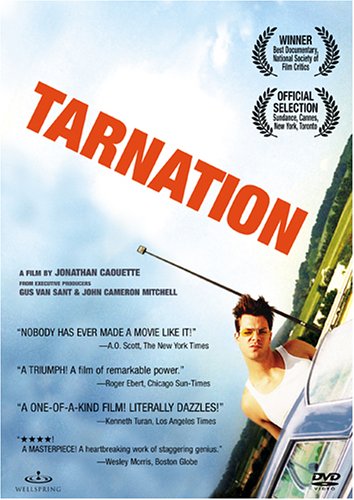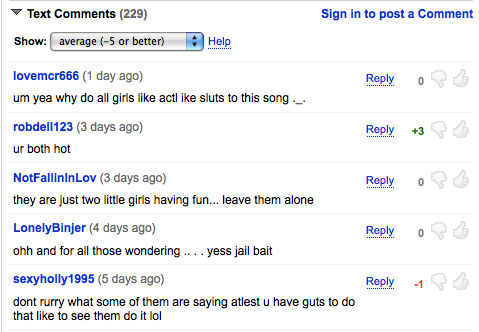Sorry to post on the U.S. election, but I came across this site and found the project quite intriguing and relative to our studies. For one, it is a project to get voters to DOCUMENT the election. Visual accounts of voting day occurrences tend to remain limited to major news networks – and I don’t need to explain that the interests of these networks determine what they do and do not air. The Internet, as a source of alternative news, independent news, diverse news, will be able to host accounts of the election as documented by people across America. A sort of political art. Issues of accessibility and fairness have plagued recent U.S. elections, yet nothing seems to get done. Perhaps this project may have some influence. Perhaps Canada needs to learn from these lovely example from our good friends to the south (and Palin’s crew to the north/west).
Archive for October, 2008
Video the Vote
Posted in Uncategorized on October 29, 2008| 1 Comment »
Tarnation
Posted in Uncategorized, tagged Add new tag on October 29, 2008| 1 Comment »
Tarnation is a great documentary. It is original. It is a provocative 88-minute experience that immerses the viewer in a very personal world.
Tarnation’s fragmented narrative construction, emotional videography and editing mimic the fragmented narrative/life of Jonathan Caouette and his family. Tarnation is a story about a subjective experience of reality, told by the person who lives it. Its power is found in Caouette’s relationship to the camera and ultimately himself. The camera is his witness.
“When I’m half asleep, there’s this plethora of information that rushes into my mind’s eye,” he said, describing his method. “It’s like a waking dream or a song or a story or a poem or a series of images, and it makes sense for just a second and then it dissipates and you think, ‘Hey, what was that?’ I wanted to take that experience and hold onto it with this film.” He has achieved his goal in “Tarnation,” which manages to seem wild and raw but also carefully constructed.’ The Man Who Was Raised by a Movie Camera by Julie Salamon. New York Times September 26, 2004
In reading interviews with Jonathan and knowing that his life long documentation collected more than 88 minutes of tape I imagined that this story could exist in all it’s versions and subplots online or as an installation. Though I love the closure of a single channel narrative the multi-channel expression if this particular work seems like a fitting if not practical expansion.
Mr. Caouette speaks wistfully of various subplots that were lost in the effort to whittle the film down to its current 88 minutes. One piece that was cut was the surprising revelation that he has a 9-year-old son. “His mom is this girl I’ve known since I was 16, and we were really, really, really good friends,” he explained. Then, with a smile, he added, “It’s a very long story.” The producers thought it might be confusing, since Mr. Caouette establishes his gay identity early in the film, and his lover, David Sanin Paz, plays an important role. Mr. Caouette’s two step-brothers – one from his mother, one from his father – also had to go. “You should see the two-and-a-half-hour version,” he said. Tracing a 20-Year Odyssey Across Hope and Despair, A. O. SCOTT. New York Times October 5, 2004
An on-line installation may facilitate a living documentary. The filmmaker may upload and present footage as it is shot. The multi-narrative presentation structure allows for more frequent performances as well as the potential to shoot in relation to audience reactions and may include a space for viewers to upload their own personal stories – producing a living web. The themes of this living documentary would include but not be limited to: family, dysfunction, identity, sexuality, love, shock therapy, personal experience of mental health, the mental health care system etc…
Web 2.0 and Youtube explained
Posted in Uncategorized on October 28, 2008| Leave a Comment »
Micro Doc #3
Posted in Uncategorized on October 28, 2008| 4 Comments »
so i added my microdoc to youtube last week and then completely forgot to complete the last and most important step. hmmm. i think the impending winter is helping me to lose my mind. i’m finally feeling good about school again. it’s been a trying few weeks. once the excitement of something new wears of the impending workload and uncertainty sets in.
standing in my kitchen making a thai red curry the other day the thought crossed my mind that i should’ve gone to culinary school and then i cracked up pretty hard because this degree feels more right to me than anything ever has. i guess questioning is just part of the process.
of course all of that has passed again. after two days of second guessing and stressing i was back on my game… except for the whole “forgetting to write this blog thing”.
so this microdoc is very different from anything i’ve ever done. i used only other people’s footage and put it all together to form my meaning out of it. so here it is.
Suzanne
a telling 6 minutes
Posted in Uncategorized on October 28, 2008| 4 Comments »
I came across this clip on YouTube in the last few weeks and I thought I’d post it because, to me, this one clip perfectly sums up Palestinian / Israeli relations.
Jeff
Getting Sidetracked (3)
Posted in Uncategorized on October 28, 2008| 1 Comment »
Just reading an article for class on thrus. and started “google-ing”
His mother couldn’t understand how he got the shoelaces.
After all, everyone knew Jarred Aranda was in danger. He had just tried to kill himself in jail.
…
he was allowed to walk into a shower, unattended, for 17 minutes. He had a set of shoelaces with him.
…
When an officer found him hanging from the shower door …
http://www.boston.com/news/local/articles/2007/12/09/a_system_strains_and_inmates_die/?page=1
– – – – – – – – – – – – – – –
On a ‘related’ note, some beautifully haunting images found on the following site:
microdocumentary #3: Barbie Girls
Posted in Uncategorized on October 27, 2008| Leave a Comment »
This was my first time using Final Cut.
What I thought was a simple idea turned into a lot more work than I anticipated!
It also turned into a great learning experience.
“Barbie Girl”
Hi Barbie
Hi Ken!
Do you wanna go for a ride?
Sure Ken!
Jump In…
I’m a barbie girl, in the barbie world
Life in plastic, it’s fantastic!
you can brush my hair, undress me everywhere
Imagination, life is your creation
Come on Barbie, let’s go party!
(repeat)
I’m a blond bimbo girl, in the fantasy world
Dress me up, make it tight, I’m your dolly
You’re my doll, rock’n’roll, feel the glamour in pink,
kiss me here, touch me there, hanky panky…
You can touch, you can play, if you say: “I’m always yours”
uu-oooh-u
I’m a barbie girl, in the barbie world
Life in plastic, it’s fantastic!
you can brush my hair, undress me everywhere
Imagination, life is your creation
Come on Barbie, let’s go party!
Ah-ah-ah-yeah
Come on Barbie, let’s go party!
uu-oooh-u
(repeat)
Make me walk, make me talk, do whatever you please
I can act like a star, I can beg on my knees
Come jump in, bimbo friend, let us do it again,
hit the town, fool around, let’s go party
You can touch, you can play, if you say: “I’m always yours”
You can touch, you can play, if you say: “I’m always yours”
Come on Barbie, let’s go party!
…
I’m a barbie girl, in the barbie world
Life in plastic, it’s fantastic!
you can brush my hair, undress me everywhere
Imagination, life is your creation
(repeat)
Come on Barbie, let’s go party!
…
Oh, I’m having so much fun!
Well Barbie, we’re just getting started
Oh, I love you Ken!
New Media Examples
Posted in Uncategorized on October 26, 2008| Leave a Comment »
I stumbled on a couple interesting examples of new media installations while browsing VVORK:
skater park micro doc
Posted in Uncategorized, tagged eekhoff skater park_micro doc 3, eekhoff_skater park on October 25, 2008| 2 Comments »
Many thanks to everyone in the lab who answered my questions and assisted me in understanding Final Cut! The 3rd micro-doc was more about discovering the use of the video camera. This micro doc served a pragmatic and utilitarian purpose for me. It claims no truth as art but assisted me in understanding the moving image and it’s marriage with sound. Specifically, let the camera “run” and shoot longer scenes – it’s not a still camera with a motor drive. Having said this, Skater Park has assisted me in formulating a shooting approach for the end of term project. I still enjoy the slow, “still” images at the end of the piece.
The choice of subject is outside of my thesis project for various reasons – mostly to explore the moving subject, “investigate” skater culture and to remove myself from “what I know” and document a subject and location completely foreign to myself. I could go on…….
DO it. (Microdoc #3)
Posted in Uncategorized on October 24, 2008| 1 Comment »
Music by Ratatat
Hey y’all here is my third micro doc. I’ve moved away from environmental issues to violence issues, which is more along the lines of what I want to focus on for my thesis. All the pictures in the video are of Canadian homocide victims. I found their pictures in articles online.
Still trying to come up with an idea for the final project, eek!


